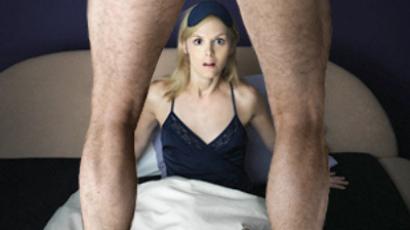One man's victory against all odds

When John Robinson was born without arms or legs his parents nearly gave him up for adoption. Today he’s a successful marketing executive, competitive golfer and family man, and will have a major television documentary.
John Robinson has got it all. The 40-year-old upstate New York media marketing executive has a beautiful wife, three great kids, a house in the suburbs, nice cars, one hell of a golf game, rugged sandy blond good looks, and a brilliant future. What’s even more incredible is that John is happy with a capital H. If he has any complaints, it’s that there isn’t enough time in the day for him to live, breathe and eat his quintessentially ‘can-do’ American Dream. John is one of those rare, humble-but-enviable individuals who has achieved everything he’s ever wanted in life, regardless of the fact that John Robinson was born without arms or legs.
Traumatic Birth
The son of David, a devout Episcopal Minister, and Priscilla, a secretary, John’s entry into this world on December 1, 1968, inside a Binghamton, New York hospital sent a shockwave throughout the delivery room. The attending medical staff was stunned silent by the sudden birth of a limbless infant. Priscilla, exhausted and weary from the surgically invasive Caesarian section, knew instinctively that something had to have gone wrong with the delivery. The baby wasn’t crying. The doctor wasn’t laying him on her chest. But before she could find anything out, the presiding gynecologist sedated her heavily. According to John, “The doctor literally knocked her out.”
Moments later, David, who had been pacing the waiting room praying for the birth of a healthy child, was greeted by an ashen-faced doctor. “You have a son,” said the gynecologist, “But…”
Priscilla would refuse to see her newborn baby. She would refuse to nurse or hold him. She made certain a ‘No Visitors’ sign was taped to the hospital room door. She and David argued again and again over one topic whether they should keep their baby.
No one expected baby John to be born a congenital amputee (ultrasound had yet to be developed). No one expected his limbs to stop developing after only five weeks. John’s arms fell short of his elbows. His legs were formed without thighs and thigh bones. He had no knees or shins. He did, however, have something resembling feet, each with two toes apiece. David anguished over the future. How would his son feed himself? How would he dress himself? How he would take care of his own most basic needs? The minister began to question his faith. How could a benevolent God do this to his child?
In the days following John’s birth, the doctor escorted a despondent Priscilla into his office. He laid baby John on a table, undressed him. He asked Priscilla to behold her son. He made her hold him in her arms. She cried and shivered, but for the first time she held her son like a mother should. After that day, she never let go.
Growing Pains
Instead of ‘institutionalizing’ their boy, the Robinsons made the steadfast decision to assimilate him into normal everyday society. John was not alone. In 1968 America, young GIs severely wounded while serving in Vietnam were returning home on a daily basis without an arm or a leg and in too many cases, without arms or legs. Many of these damaged people were not hiding themselves from society. They were entering it. They were becoming productive citizens.
Like those handicapped veterans, John would one day be confronted with a choice: he could either give up on life or he could turn his severe handicap into an opportunity. Perhaps that first opportunity unknowingly arrived when his baby sister began to crawl. The three-year-old John got jealous of all the attention she was getting. He picked himself up and began to learn how to walk. As a boy he would walk with a curious, but confidant waddling gait. He would learn to use both stunted arms as a single hand would an index finger and an opposable thumb. In this manner he learned to pick up a fork, write his name, grip a golf club his father cut down to size for him, even drive a riding mower on his grandparent’s New Hampshire farm.
As a grade school student, he would be fitted with prosthetic devices in order to make him more mobile and to make him appear more normal. They did neither. The cumbersome devices made it uncomfortable for him to walk. They didn’t feel natural. They didn’t look natural. John was born without arms or legs. That was natural.
In junior high, he was expected to climb several flights of stairs several times a day. He couldn’t climb them while wearing false legs. In what would become a typical demonstration of steadfast will and determination, John would toss out his prosthetic devices for good.
One of most basic of those many challenges would prove frustrating for John all the way up until his senior year of high school. Having set his sights on attending college away from home, it was imperative that he learn to dress himself without any assistance. How did he solve the problem? The first step was to cop the right attitude. According to John:
“When I see a challenge ahead, I take time to think about it, and then I come up with a solution.”
That solution was the material miracle called Velcro. For the first time in his life, John was able to button his pants by substituting Velcro for buttons.
Independent Individual
Throughout the course of his 40 years, the 3’9” John has learned to overcome challenges that would seem second nature for a person born with ordinary limbs. He’s learned to type, throw a ball, drive a car (with the assistance of mechanical extensions), feed himself, dress himself, tie a neck-tie, use a cell phone and just about any electronic device that seems inoperable for a person without fingers.
He’s also learned to become a more than competent golfer. A typical drive for John is 150 yards, and he often competes in tournaments while crediting the United States Golfer’s Association handicap system for providing him with a ‘fairly even playing ground’. Something he hasn’t always enjoyed the benefit of in the working world.
Before John landed his job as Director of Corporate Support at New York’s WMHT, he spent four years traveling the US and Canada in search of a media sales position. He recounts one instance where he got off a plane to meet his potential sales management employer. Not expecting a ‘first impression’ encounter with a man possessing John’s disabilities, the manager turned white. “That pretty much ended the interview right there,” John recalls.
This summer John’s life will become the subject of a US Public Broadcasting television special, “Get Off Your Knees.” His inspirational autobiography of the same title will be published by a university press. Family man, media marketing exec, competition golfer, motivational speaker, is there anything this guy can’t do?
When asked if he’s ready for fame, John shrugs his muscular shoulders and makes a sly grin. He mentions the recent popularity of limbless Mixed Martial Arts sensation Kyle Maynard, who fought a man with limbs on international television.
“He reminds me of when I was his age,” John smiles. “I just hope that he’s true to himself.” In other words, John hopes that Kyle isn’t just cashing in on his disability in exchange for fortune and glory.
Would John trade in his current, relatively anonymous life for a pair of arms and legs? “I’d like to know how it feels for a day,” he admits. “But I wouldn’t give up my family…No way.”
By a strange twist of biological fate, John not only used to dream about running on normal legs and throwing a ball with normal arms, to this day he can feel where his limbs would have been. Because he still retains the nerves to his arms and legs, he can point his fingers, make a fist, kick his feet, “even give somebody the finger” without them having a clue.
Weeks ago an editor for a major New York publisher was presented with an informal pitch for John’s life story. Said editor did indeed envision commercial publishing possibilities. “However,” she cautiously asked, “What’s the hook?”
Was John about engage in a transcontinental walk? Was he about to climb Mount Kilimanjaro? Was he going to swim the Black Sea? How could she justify a six-figure advance if there was no hook?
“The hook,” John smiles, “is that there is no hook…I’m everyman and I’m already living the American dream.”
Vincent Zandri for RT














